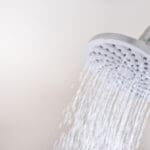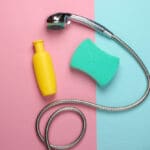Transforming your bathtub into an oasis with the simple addition of a handheld shower head is akin to turning a blank canvas into a masterpiece—both require precision, care, and the right tools.
Key Takeaways
- Gather all necessary tools and materials before starting the installation process.
- Turn off the water supply and remove existing fixtures carefully to avoid damage.
- Properly install the diverter valve for easy toggling between handheld showerhead and tub faucet.
- Secure all connections and test for leaks and consistent water pressure before finishing.
Gather Your Tools and Materials
Before you begin installing your new handheld shower head, you’ll need to gather a few essential tools and materials. This first step is crucial to ensure a smooth installation process and to avoid any unnecessary interruptions once you start.
Your handheld shower head kit should typically include all the necessary components, such as the shower head itself, a hose, and possibly a mounting bracket and diverter if you’re planning to attach it to your tub faucet.
Make sure to have plumber’s tape on hand as well; it’s a vital component for securing the connections and preventing leaks. This tape, when wrapped around the threads of the connection points, helps to create a tighter seal. It’s especially important when you’re connecting the diverter to your tub faucet, a step that makes it possible to switch water flow between the faucet and the handheld shower head.
As for the basic tools, a wrench and a pair of pliers are usually sufficient for the job. These will help you tighten or loosen connections as needed.
Remove Existing Fixtures
After gathering your tools and materials, the next step involves turning off the water supply to your bathtub and removing any existing shower fixtures. This is crucial to prevent any water mishaps while you’re working on installing your new handheld showerhead. You’ll need to ensure that the water flow to your shower or tub is completely halted before proceeding.
Next, grab your adjustable wrench or pliers to start the removal process. Before you twist anything, wrap the old showerhead with a piece of cloth or leather. This protective layer helps in avoiding any scratches or damage to the finish as you remove the old fixture. It’s a simple step that preserves the aesthetics of your bathroom fittings.
Once the existing shower head is detached, take a moment to clean the threads on the shower arm thoroughly. You’re likely to find mineral deposits or remnants of old pipe compound, which can hinder the installation of your new addition. A clean thread ensures a smoother installation process.
Don’t forget to apply plumber’s tape clockwise around the threads. This step is essential for creating a tight seal, ensuring that your new handheld shower head won’t face any leak issues.
Install the Diverter Valve
To install the diverter valve, start by threading it onto the shower arm, ensuring a snug fit to direct water flow between your new handheld showerhead and the tub faucet. This step is crucial for the overall functionality of your shower system, as the diverter valve acts as the switchboard for where the water is directed. When properly installed, it allows you to easily toggle between using the handheld showerhead and the tub faucet, enhancing your bathing experience.
To ensure a successful installation of your diverter valve or spout diverter, follow these steps:
- Wrap the threads of the shower arm with plumber’s tape to ensure a watertight seal, preventing any leaks.
- Hand-tighten the diverter valve onto the shower arm to avoid cross-threading, which could damage the threads and lead to a poor seal.
- Use an adjustable wrench for the final tightening, but do so gently to avoid overtightening, which could crack the fitting.
- Test the diverter’s functionality by running water and switching between the showerhead and tub faucet, checking for any leaks or issues in operation.
Install a diverter properly to enjoy a seamless transition between your handheld shower and the tub faucet, ensuring a versatile and enjoyable bathing experience.
Attach the Handheld Showerhead
Once you’ve got your diverter valve in place, it’s time to focus on attaching the handheld showerhead to ensure your setup is fully functional. Begin by taking the handheld shower hose and attaching one end to the outlet of the shower diverter. Make sure it’s screwed on tightly to prevent any water leaks.
Next, attach the other end of the handheld shower hose to the base of the handheld showerhead. This connection should also be secure and tight. If your showerhead kit comes with rubber washers or seals, ensure they’re in place before screwing the parts together to provide an extra layer of leak protection.
After both ends of the hose are securely attached, hang the handheld showerhead on its holder or bracket. The holder should be mounted on the wall or shower area at a height that’s comfortable for you to reach and use. This might require drilling into the wall, so have the appropriate tools and wall anchors ready if needed.
Secure and Test Your Setup
Ensure all connections are tightly secured with an adjustable wrench or pliers before testing your new handheld shower setup for leaks. This is a crucial step to avoid water damage and ensure your setup works perfectly from day one.
Here’s how you can secure and test your setup efficiently:
- Tighten all connections: Use an adjustable wrench or pliers to ensure a secure fit. This prevents leaks and maintains proper water flow.
- Check for leaks: Turn on the water and visually inspect around the showerhead, hose, and connections for any signs of leaking. Small drips can lead to bigger problems if not addressed.
- Adjust as necessary: If you find any leaks, tighten the fittings or connections where you see water escaping. This might require some adjustments to get a perfect seal.
- Test for functionality: Activate your handheld showerhead to spray water, checking for consistent water pressure and flow. This confirms everything is working as it should.
After completing these steps, you should have a fully functioning and leak-free handheld shower setup. Don’t hesitate to make any necessary adjustments or repairs to secure and test your setup, ensuring it delivers optimal performance.
Frequently Asked Questions
Can You Attach a Handheld Shower Head to a Bathtub?
Yes, you can attach a handheld shower head to your bathtub. It’s a straightforward process that improves your bathing experience. Just ensure you’ve got the right tools and follow the installation guidelines carefully.
Can I Add a Handheld Shower Head to My Existing Shower Head?
Yes, you can add a handheld shower head to your existing shower head. You’ll need a diverter to split the water flow between the two heads. Ensure it fits your current setup before purchasing.
How Do You Install a Shower Head in a Bathtub?
To install a shower head in your bathtub, you’ll need to attach it to the water supply, ensuring it’s secure and leak-free. Don’t forget to consider height and positioning for the best experience.
How Do You Add a Shower to an Existing Bathtub?
To add a shower to your existing bathtub, you’ll need to install a diverter spout, mount a shower head, and ensure proper waterproofing. Don’t forget to check local codes and consider hiring a professional.





